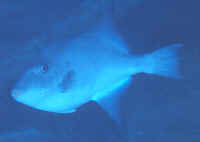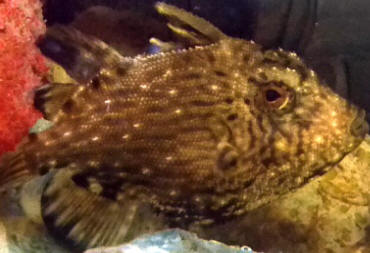|
FAQs about Canthidermis
Triggerfishes
Related FAQs: Triggerfishes
in General, Triggerfish: Identification,
Selection, Selection 2,
Compatibility,
Behavior, Systems,
Feeding,
Diseases,
Triggerfish Health
2, Reproduction,
Related Articles: Canthidermis
Triggers, Triggerfish, Balistoides Species, Red Sea Triggerfishes,
|

|
Triggerfishes for Marine Aquariums
Diversity, Selection & Care
New eBook on Amazon: Available here
New Print Book on Create Space: Available
here
by Robert (Bob) Fenner |
 |
|
Care for Canthidermis maculata 10/6/11
Howdy from Galveston!
<Oh! Have visited there... Moody's... some nice
restaurants>
Each year see's me out collecting, primarily on the
beachfront and jetties of Galveston Island. Directly after
Hurricane Don, I took the opportunity to collect on the
beachfront as a result of the unusually high/low tides.
As the tide makes its way out, tide pools appear behind the
granite blocks at the West end of the seawall. Many of these
pools dry at low tide, and are filled with its return. While it
isn't often I keep much from these forays, every
once-in-awhile something is found which piques my interest, which
brings me to the subject of my email.
In one of these draining pools, a small shore bird was trying to
grab what appeared to be a piece of flotsam. As I approached, it
became clear that it was some kind of fish-usually it is a
Lobotes surinamensis which has become trapped, and I figured it
would be best to just toss it into the surf and give it a
fighting chance. When I got to the fish in question, it became
immediately apparent that my original assumption was
incorrect.
Once in the dip net I knew the fish to be a triggerfish of
some-sort, but was unable to specifically ID it on site, so it
got to tag along for the ride to my house. The little guy
(2") was in a grave state with pecked skin, torn fins, and a
stressed coloration:
[Canthidermis maculata2.JPG]
[Canthidermis maculata.jpg]
Once he settled down and his coloration returned to normal, I
determined it to be Canthidermis maculata. I'll have to take
some updated pictures, as his coloration is now slate with blue
dots...Unless he's eating, then he can change to yellow body,
white spots, and black fins.
<Typical juvenile...>
After reading wet web media's conclusion that these fish
aren't well-suited to life in an aquarium
<Mmm, are fine when young>
it seemed as though I was at a bit of an impasse. Even though I
only keep animals collected from the areas previously listed, my
rock is dead rock which has been resurrected in bait live wells,
and I feed locally caught grass shrimp/snails/squid/crab, I'm
not overly keen with releasing fish having been kept in an
aquarium.
<Am generally against this practice as well... but in your
case... w/ naught but locally collected matter,
livestock...>
The aquarium in which he currently resides is a
48"x24"x24" Tenecor with a 30g sump including:
skimmer, refugium, and DSB. Lighting is (4)x 48" t5
fluorescent.
Included livestock are 3 Sergeant Majors, 3 Seaweed blennies,
Sharpnose puffer (2") and a Chasmodes of some sort.
He is eating well, and all the injuries have healed, but I do not
wish to watch him languish with age/size. If he is to become a
permanent resident of my aquarium, what would be the
recommendations of your staff so that he remains the happiest
possible?
Scott McDonald, RS
<Really just simple feeding and aquarium maintenance... IF you
perceive the specimen is getting too large... a return trip to
the sea. Cheers, Bob Fenner>
|
|

|
|
Re: Care for Canthidermis maculata
10/6.5/11
Thanks Bob!
General question- I have photographed some juvenile fish
collected in Galveston, TX and would be more than happy to share
them with you. Photos include: Scartella cristata (Molly Miller
Blenny), Chasmodes either bosquianus or longimaxilla-(jury is
still out), Parablennius marmoreus (Seaweed blenny), Histrio
histrio (Sargassum Frogfish), Serraniculus sp. (Pygmy Seabass),
Lutjanus apodu, (Schoolmaster snapper), Chaetodipterus faber
(Atlantic spadefish), and Lobotes surinamensis (Tripletail).
Let me know where to send them and any size requirements.
-Scott
<Thank you for your offer Scott. Please do send along...
.jpg's are fine... about a meg each; and I'll post w/
credit to you. Cheers, BobF>
|
Triggerfishes for Marine Aquariums
Diversity, Selection & Care
New eBook on Amazon: Available here
New Print Book on Create Space: Available
here
by Robert (Bob) Fenner |
 |
|
|

